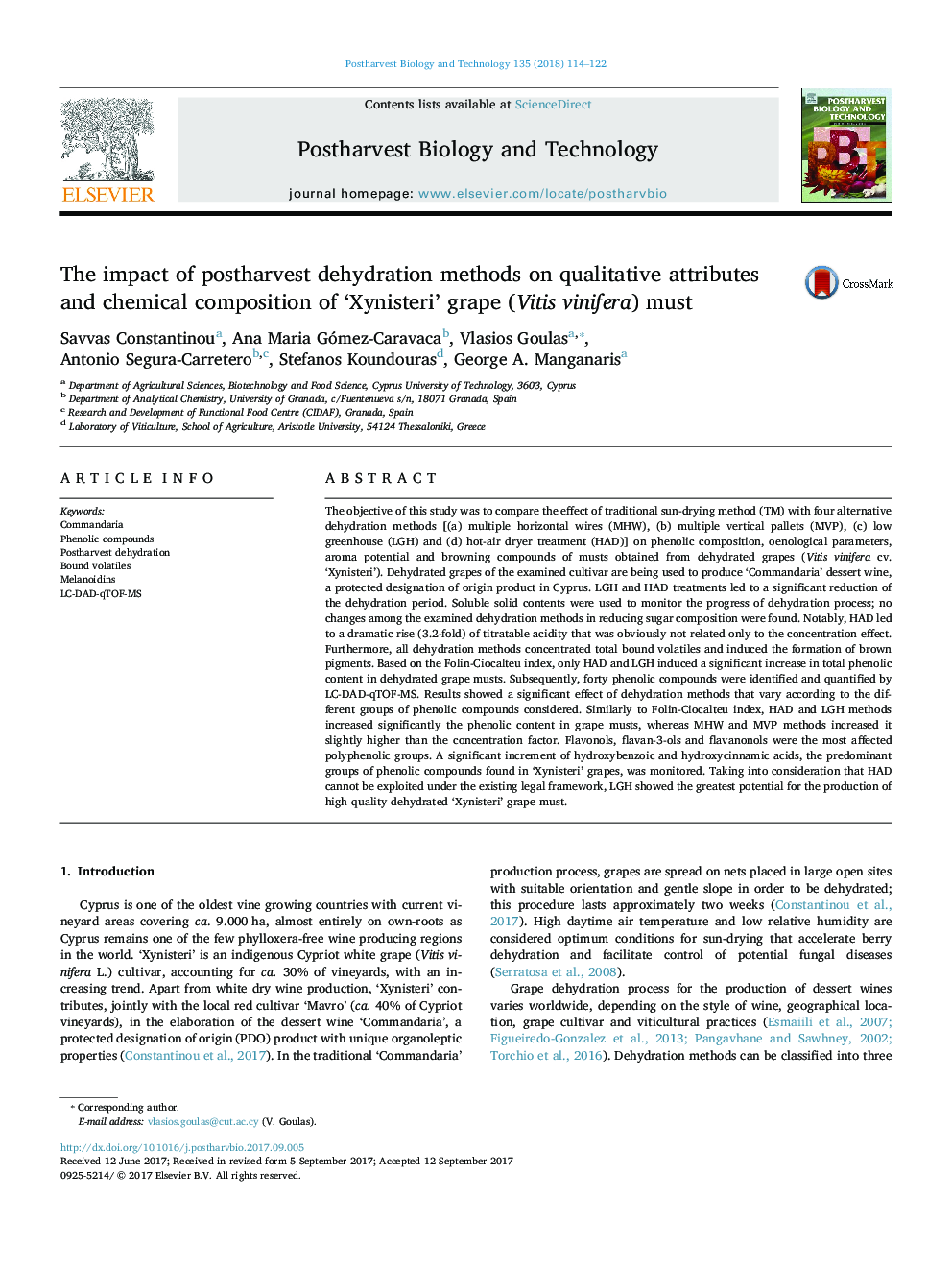| کد مقاله | کد نشریه | سال انتشار | مقاله انگلیسی | نسخه تمام متن |
|---|---|---|---|---|
| 5762634 | 1624959 | 2018 | 9 صفحه PDF | دانلود رایگان |
عنوان انگلیسی مقاله ISI
The impact of postharvest dehydration methods on qualitative attributes and chemical composition of 'Xynisteri' grape (Vitis vinifera) must
دانلود مقاله + سفارش ترجمه
دانلود مقاله ISI انگلیسی
رایگان برای ایرانیان
موضوعات مرتبط
علوم زیستی و بیوفناوری
علوم کشاورزی و بیولوژیک
علوم زراعت و اصلاح نباتات
پیش نمایش صفحه اول مقاله

چکیده انگلیسی
The objective of this study was to compare the effect of traditional sun-drying method (TM) with four alternative dehydration methods [(a) multiple horizontal wires (MHW), (b) multiple vertical pallets (MVP), (c) low greenhouse (LGH) and (d) hot-air dryer treatment (HAD)] on phenolic composition, oenological parameters, aroma potential and browning compounds of musts obtained from dehydrated grapes (Vitis vinifera cv. 'Xynisteri'). Dehydrated grapes of the examined cultivar are being used to produce 'Commandaria' dessert wine, a protected designation of origin product in Cyprus. LGH and HAD treatments led to a significant reduction of the dehydration period. Soluble solid contents were used to monitor the progress of dehydration process; no changes among the examined dehydration methods in reducing sugar composition were found. Notably, HAD led to a dramatic rise (3.2-fold) of titratable acidity that was obviously not related only to the concentration effect. Furthermore, all dehydration methods concentrated total bound volatiles and induced the formation of brown pigments. Based on the Folin-Ciocalteu index, only HAD and LGH induced a significant increase in total phenolic content in dehydrated grape musts. Subsequently, forty phenolic compounds were identified and quantified by LC-DAD-qTOF-MS. Results showed a significant effect of dehydration methods that vary according to the different groups of phenolic compounds considered. Similarly to Folin-Ciocalteu index, HAD and LGH methods increased significantly the phenolic content in grape musts, whereas MHW and MVP methods increased it slightly higher than the concentration factor. Flavonols, flavan-3-ols and flavanonols were the most affected polyphenolic groups. A significant increment of hydroxybenzoic and hydroxycinnamic acids, the predominant groups of phenolic compounds found in 'Xynisteri' grapes, was monitored. Taking into consideration that HAD cannot be exploited under the existing legal framework, LGH showed the greatest potential for the production of high quality dehydrated 'Xynisteri' grape must.
ناشر
Database: Elsevier - ScienceDirect (ساینس دایرکت)
Journal: Postharvest Biology and Technology - Volume 135, January 2018, Pages 114-122
Journal: Postharvest Biology and Technology - Volume 135, January 2018, Pages 114-122
نویسندگان
Savvas Constantinou, Ana Maria Gómez-Caravaca, Vlasios Goulas, Antonio Segura-Carretero, Stefanos Koundouras, George A. Manganaris,